Blog
Mongolian Horse Culture & Horsemanship
To appreciate the Mongol you must see him on horseback, and indeed you rarely see him otherwise.
The domestication of horses has radically transformed human culture— altering the way we eat, organize, and interact to a great extent. However, it is in Mongolia, where this impact is more apparent than any other nation in the world. Mongolia boasts more than 5 million horses, an equine population which almost doubles the country's human population. Elizabeth Kimball Kendall, an author who traveled through Mongolia in 1911, commented, “To appreciate the Mongol you must see him on horseback,—and indeed you rarely see him otherwise, for he does not put foot to the ground if he can help it. The Mongol without his pony is only half a Mongol, but with his pony, he is as good as two men.” Undeniably, Mongols have a reputation for being the greatest horsemen on earth. Children in the countryside learn to ride a horse when they are 3 to 5 years old and start racing from 6 to 12.
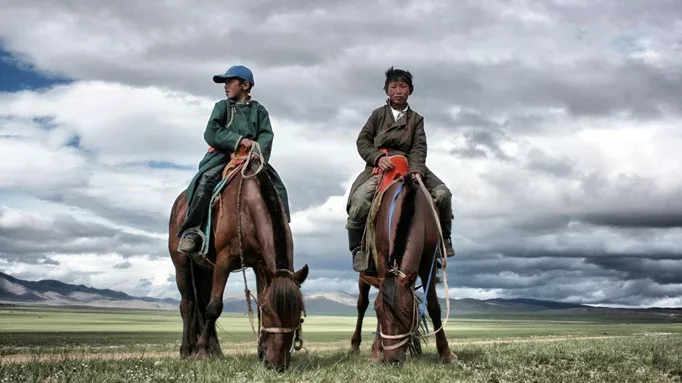
Mongol horses, a native breed of the country, are historically known for their role in the military campaigns of Genghis Khan, who established an empire that extended from Hungary to Korea and from Siberia to Tibet. As a war vehicle, the Mongol horses were far more superior than any other breeds in use at the time. They needed little water and did not require to be fed by daily supplies of grain, as many European breeds did. Their ability to search beneath the snow and find their own food enabled the Mongol army to mount successful winter campaigns against Russia. Their long-distance endurance allowed warriors to outlast enemy cavalry during battle. The only weakness of the Mongol horse as a war steed was that it was slower than the other breeds it met on the battlefield. However, this disadvantage was atoned by the fact that it usually carried less weight than the enemy cavalry. Each warrior usually brought at least 3 to 5 horses with him as remounts. Historically, the Mongol conquest was not the only time for these horses to prove their strength. During World War II, Mongolia was the sole supplier of horses for the Soviet Union, providing half a million steeds. One of every five horses in the war front was from Mongolia. A memorial statue, depicting a Mongol horse carrying heavy guns to Berlin, was set up in Moscow. Reckless, a Mongolian mare that served in the Marine Corps during the Korean War, became the only horse in US history to have been promoted to the rank of sergeant. The horse made 51 solo trips during a five-day battle in March 1953, carrying nearly 4500 kg of ammunition and explosives from a supply depot to the front lines. She also evacuated wounded and dead from the battlefield and quickly earned the respect of all the Marines who served with her.

Today, outside its capital Ulaanbaatar, horses are still the main means of transportation in Mongolia. They are also valued for their milk, meat, and hair. In summer, mares are milked six times a day, once every two hours. By fermenting horse milk, families make a mildly alcoholic beverage known as Airag. In addition, mare's milk has been used in ceremonies of purification, prayer, and blessing since ancient times. In the Secret History of the Mongols, it is recorded that Genghis Khan sprinkled mare's milk on the ground to pray to a mountain that hid him from his enemies. Horsehair is used in the creation of musical instruments called morin khuur. In Mongolia, it is typical for a nomadic household to have over 200 horses. As each family member has his or her own horse that they ride regularly, individual horses are ridden somewhat infrequently. As a result, most of the horses become semi-wild and must be caught and broken anew each time they are used. To catch a horse, a herdsman mounts a trained catch-horse, which is always fast and agile, yet calm enough for action. The herdsman chases after the horse he wants and loops the lasso around its neck. Then he pulls back on the looped horse until it wearies and stops running. At this point, another rider will come up and put a saddle on it and mount. The horse will initially run and fight, but it will eventually remember its earlier training and obey its rider.
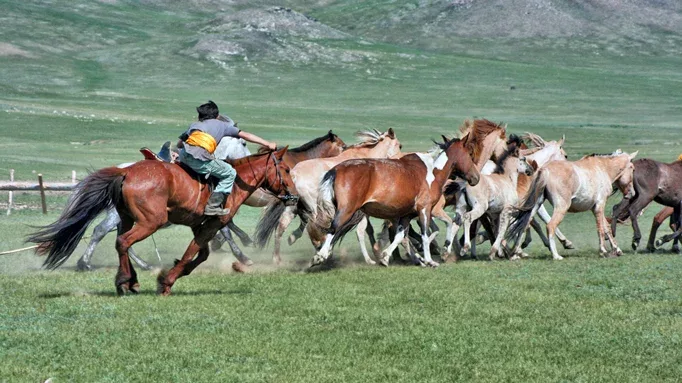
When it comes to horse care, Mongolians use a rather "hands-off" method. In Mongolia, barns, pastures, and stables are not common. Horses live outdoors all year, dealing with temperatures from 45 °C in summer, down to −45 °C in winter. Horses are not bathed or fed special foods like grain, vegetables, or hay. They graze on the steppes and even remove snow with their hooves to eat the grass underneath in winter. For water, they eat snow or drink from rivers and lakes. Since they cost little to nothing to raise, horses are not a luxury item like in Western culture. Mongol horses do not require much of hoof care. They have solid, strong hooves and rarely experience foot problems. Also, Mongol horses are very winter-resilient. The winter months sometimes weary out the horse tremendously, that in spring they are too weak to be ridden. Yet, they manage to recover instantly when new grass appears. Despite living in harsh conditions, most horses live to be 20 to 30 years old. When a favorite horse dies, the owner disposes of the remains in respectful ways. They usually take the horse's skull and place it on an ovoo, a pile of rocks used in the shamanic religion. If a horse is killed for food, its skull should be left in the field because of the sacredness of the horse. It is a taboo to step upon a horse's skull or hooves. Mongolians train the horses to be ridden when they are already three years old, to avoid back problems. The training process is very simple. The rider gets on and lets the horse run until it is exhausted. Then the horse is taught to respond to the pull of the reins. In general, Mongolian horsemen know everything necessary to care for horses. Families do not employ outside specialists such as trainers or farriers. For exceptionally difficult problems, the local elders may be called in or a vet. Books on horse training or medical care are rare and hardly ever used. Instead, hereditary knowledge is passed down orally from parent to child.
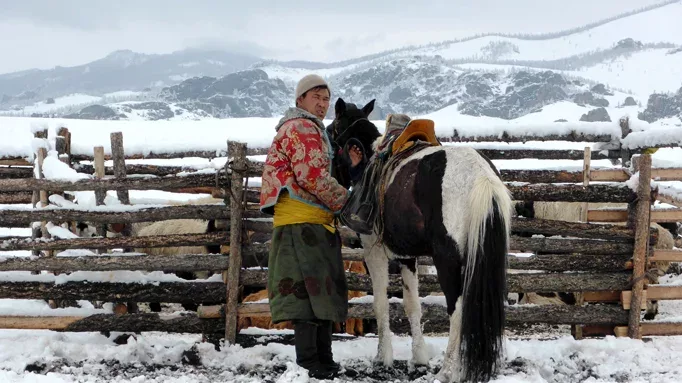
The horses, that are ridden daily, are mostly tied up to a hitching post. The rest of the horses roam freely on their own, without much supervision from a herdsman. As a matter of fact, stallions are normally entrusted with a task to lead the herd, sire foals, and protect the herd against wolves. One stallion may watch over a herd consisting of 15 - 50 mares. The stallions actively look after the mares and fight with any other stallion which attempts to join the herd. In many cases, the owner only needs to count his stallions to tell that all the mares have returned home. Mongolians believe that the spirit of a stallion resides within his mane. Thus, the mane of a stallion is never cut, though the manes of geldings are. Castration is carried out in spring when a colt is 2 years old. The colts to be neutered are caught and their legs are tied. The genitals are washed, then cut off with a knife that has been cleaned in boiling water. Afterward, the wound is rinsed with mare's milk, a practice intended to stimulate healing. The animal does not seem to feel much pain during the operation but experience a state of confusion when it is let loose later. Depending on the number of colts to be castrated, several households may participate so that the procedure may be completed within a day. When the work of castration is done, the testicles are used for ritual purposes. One of the removed testicles is pierced with a knife to permit the insertion of a rope. The rope is then fastened to the new gelding's tail with the belief that once the testicle has dried, the wound will completely heal. The remaining testicle is cooked in the ashes and eaten by men to attain the vitality of the stallion. Regardless of how unnatural it seems; gelding is a traditional way to remove lower-quality animals from the gene pool.
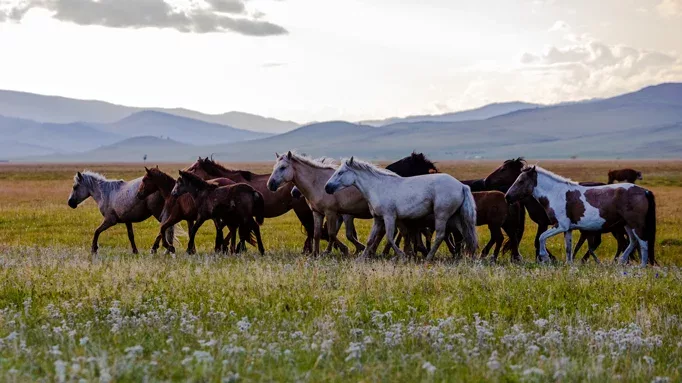
Mongolians do not usually name their horses. Rather, they identify them by their color, markings, scars, and brands. There are over 500 words in the Mongolian language describe the traits of horses with 250 terms for coat color and pattern. Families often brand horses to demonstrate ownership. Brands traditionally indicated ancestral positions of owners in patrilineal kin-groups, including offices held, aristocratic or serf standing, and religious or lay status. Horse-breeders brand the foals when the milking season ends in September. To perform a branding ritual, a fire is set near the tethering-line. There an iron brand is made red hot. Each foal or colt is then branded one by one, after which the brand is dipped into a bucket of fermented mare’s milk. The bucket is brought into the ger to be served at the “Feast for Branding Foals”, where guests are invited to celebrate the joyful day. From time to time, a family selects a sacred horse among their herd, which can be identified by a blue scarf tied around the neck. The horse is generally never ridden, though on rare occasions the head of the household may do so.

Due to the small stature of the native horses, Mongolian tack is very light compared to western tack. It is made almost completely of leather, using knots instead of metal connectors. Tack design follows a size-free approach, in which saddles, halters, and bits all produced in a single size. The Mongolian riding saddle is very tall, with a wooden frame and several decorated metal parts that stand out from the sides. It has a high pommel and cantle and is placed upon a felt saddlecloth to protect the horse's back. The design of the Mongolian saddle provides minimal control over the riding speed. In most situations, the horse will decide the gait on its own, while the rider is busy with other tasks such as herding cattle. Mongolian saddle has short stirrups like those used by racehorses. It allows the rider to control the horse with his legs, leaving his hands free for tasks like archery or holding a lasso. Riders can easily stand in the stirrups while riding.
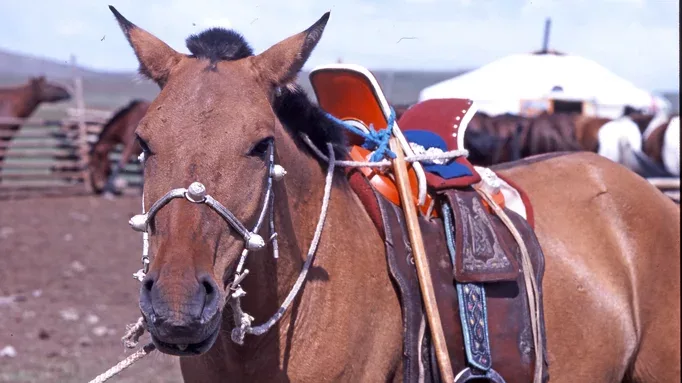
Since the late 2000s, with motorcycles and cars becoming common usage, the transportation role of horses is slowly declining in Mongolian life. However, the horse culture is nowhere near extinction, as horses are not just vehicles, but one of the most important cultural carriers for Mongolians. A man with many horses is considered wealthy. Thus, it has become trendy among the city elites to own several herds of horses or to breed racehorses. For the rich, $10000 seems a reasonable price to pay for a reputable horse breed. In recent years, politicians have employed the symbolic gifting of horses for diplomacy. Traditionally a sign of great respect, the gift of a horse is one of the most culturally significant ways to honor another individual in Mongolia. This unique approach has grabbed international headlines of news outlets, such as the New York Times, Reuters, and Foreign Policy. The practice was performed twice in 2019, with Donald Trump and US Defense Secretary Mark Esper. In Mongolia, most people can still ride even today. Many kids, born in the city, go to the countryside for vacations with their parents and learn to ride horses. As the saying goes, “A Mongol without a horse is like a bird without wings.”
Horse breeders' paradise
Central Mongolia, commonly known as the Horse Breeders’ Paradise for its serene beauty, is a land of flourishing green meadows, rolling hills and crystal blue lakes and rivers lying at the northern foot of the Khangai Mountain Range. This is where many nomadic families are herding their livestock, and a great place to experience the Mongolian Horse Culture at first hand. Come with us on our Central Mongolia Tour that has been specially designed to accommodate travelers of every age, going at an easy pace that would allow one to truly absorb the unique tranquility Mongolia.
VIEW TOUR